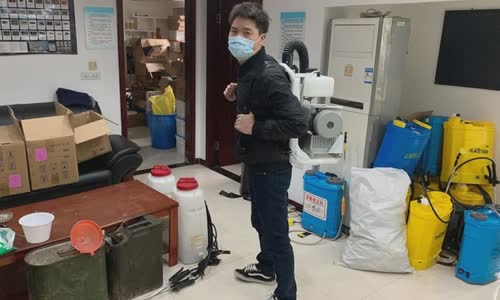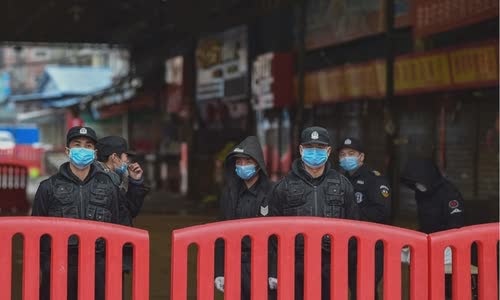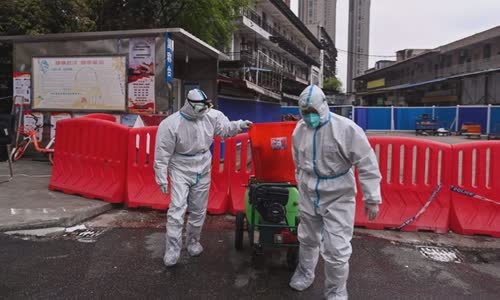China initially seemed to want to quickly identify the origin of the nCoV, but later did not share information and cooperate with international investigations.
Around 1 am on December 31 last year, Lu Tuan Khanh woke up when he received a call from his boss at Khuong Duy sterilization company.

Lu Tuan Khanh tested disinfection equipment at Khuong Duy Company in Wuhan Photo: WSJ.
Lu knew the bazaar market with maze-like stalls located near this train station, but at that time he did not know it was suspected of the origin of Covid-19.
When his team started spraying disinfectants, officials also took samples from counters, sewers, and market goods.
More than 4 months later, Chinese officials have yet to share with the world any data about the samples Lu and the group have collected.
China's lack of transparency and unwillingness to participate in international investigations have sparked speculation and criticism.
At first, Chinese officials seemed eager to find a way to quickly identify the source of the pathogen.
But China subsequently changed its attitude abruptly, becoming increasingly skeptical of the origin of the virus, refuting any theories that nCoV originated in the country, while also rejecting any calls for international investigations.
Zhao Lap Kien, spokesman for the Chinese Ministry of Foreign Affairs, even made an unwarranted remark that an American soldier brought the virus to Wuhan when he arrived in the city for the year-end World Military Olympics.
The US-China relationship has become worse and worse as the two sides have constantly made mutual accusations about the origin of the virus.
Beijing and the head of the Wuhan Virological Institute immediately denied, accusing the United States of spreading false information for political purposes, when the US presidential election was near.
"This virus is not related to any particular country, region or group of people. All countries in the world should work together, instead of blaming and avoiding responsibility," the statement said.
But when foreign researchers and officials wanted to go to Wuhan to embark on investigations, they soon became frustrated by obstacles from China.
Clifford Lane, clinical director at the National Institute of Allergy and Infectious Diseases, who joins the WHO expert group, said they only discussed the market and the possibility of zoonotic viruses with others.
(CCDC) committed to the WHO expert group that they would create an epidemiological map of the Hoa Nam seafood market, showing in detail which animals were sold where, which patients had been to the site.
CCDC did not comment on this.
The WHO has frequently requested that the Chinese government update information about the virus origin investigation, but received no reports, the agency said in an email to WSJ.

Police and security personnel erected barriers outside the Hoa Nam market, Wuhan, January 24 Photo: AFP.
So far, China has only published the genetic sequences of "environmental biological samples" taken from sewers, stalls and garbage trucks, not directly collected from animals at the Hoa Nam market.
Some also reported that Chinese officials told them that the animals in the market were destroyed.
Chinese officials said they had traced the suppliers of wildlife meat at the market, but they had never provided any information about this group of people or the animals they brought to the South China market.
According to a CCDC report, the WHO team to Wuhan collected 585 samples of which 33 were positive for the virus.
The National Health Commission of China only announced that the Ministry of Science and Technology is carrying out this task, according to WHO.
"The information about the investigation is extremely important to public health, because it could be the key to helping prevent many other diseases," WHO said.
The Food and Agriculture Organization of the United Nations (FAO) also plans to send a team of experts to China for several weeks to study the animal origin of the virus.
EcoHealth Alliance, a non-profit organization in New York, USA, who has studied corona virus in China for 15 years, also offered to support the investigation, according to chairman Peter Daszak.
Daszak said he and his colleagues in China could not investigate the market.
Comparing the market of Hoa Nam market to the scene of a case, Daszak said that because the evidence here is likely to be disturbed or accidentally destroyed, the best option today is a large-scale test to detect.
"This is not easy and quick, but it will help us reach our destination. However, this needs cooperation between China and many other countries, including the US," he said.
Many health experts believe that nCoV exists naturally in bats and can be transmitted to humans through wildlife such as civets or pangolins.
These are sensitive questions because most of the wildlife trade in China is illegal and strict epidemiological testing is not done regularly.
Lu, an employee of Khuong Duy fumigation company, said that when he arrived with the team on December 31, he did not see any civet, pangolin or bat in the market.
Officials of Wuhan CDC office and a team of experts from CDC in Beijing arrived in the South China market on January 1, when the market was closed.

Sterilizing staff at Hoa Nam market, Wuhan, March 30 Photo: AFP.
When medical experts from Taiwan and Hong Kong arrived in Wuhan in mid-January, a local CDC official said that wildlife in the market was not found and locals seldom ate such things.
Ian Lipkin, a virologist at Columbia University who last January went to China to help deal with the virus, also said the Chinese he met said that CCDC staff had sampled biological products from animals and meat in
Lipkin, who has been involved in efforts to cope with the SARS epidemic, added that George Gao, director of CCDC, initially believed that the culprit responsible for Covid-19 was a type of meat that was sold for meat in China.
"After thorough research and research on this type of mace, including live, dead or frozen animals, they did not detect anything unusual and had to change their course."
Lipkin also said that director Gao insisted that Chinese scientists found the virus in biological samples taken from the environment but could not identify the animal.
Lipkin said he and a Chinese colleague had suggested other ways to identify the source of the virus, such as testing blood samples of pneumonia patients across the country before December, to see if it was the case.
However, Chinese officials have yet to allow access to the relevant samples, according to Luc Gia Hai, Lipkin's colleague and now works at Sun Yatian University.
The consensus that bats are the main carrier of the virus comes from the research published on January 23, stating that the genome of nCoV is 96% similar to another corona virus found in the past.
A week ago, CCDC researchers published a report that also concluded that bats are most likely hosts, but suggested that the virus transmitted to humans via an intermediate host was wildlife in the Hoa Nam market, because
The conclusion that animal-derived viruses are not only a concern for WHO, but also for the World Animal Health Organization (IOE), an international body based in Paris, France and China
The minutes of this conference stated that all biological samples taken from several market animals were not positive for the virus, but did not provide information on the number of samples and the types of animals sampled.
The organization recommended a comprehensive investigation of wildlife trade in China, covering all conduct related to the trade, as well as the management of live food markets in Wuhan.
OIE also said it has contacted veterinary officials in China and offered to help investigate the origin of the virus, but no agreement has been reached.
Minutes of recent months of meetings with Chinese experts suggest that China has tested domestic animals, as well as on animal farms, but did not detect viruses, but did not mention them.
"The problem is that it should have been done by the end of December or early January. It's too late now, which means we'll have to rely on other indirect evidence. Therefore, the cause of the pandemic



 Foziya Khan
Foziya Khan







